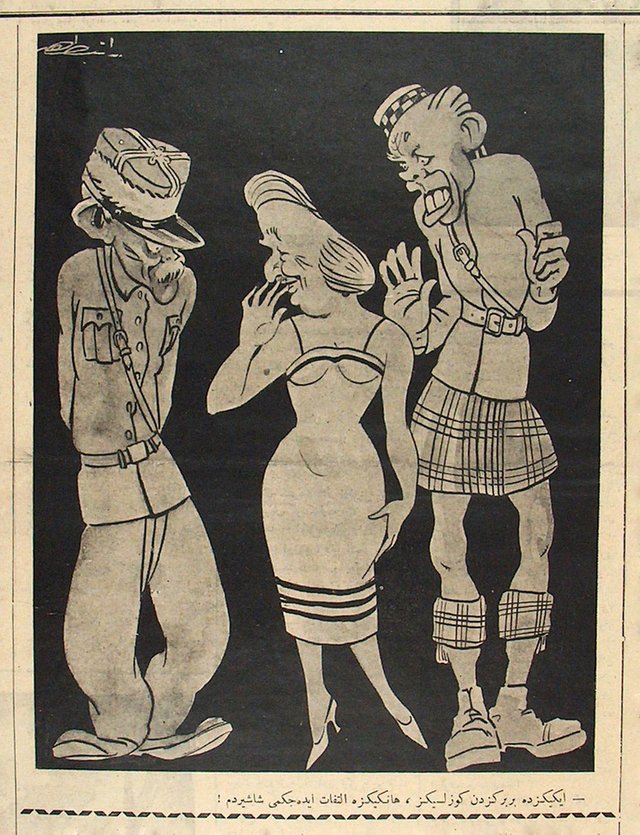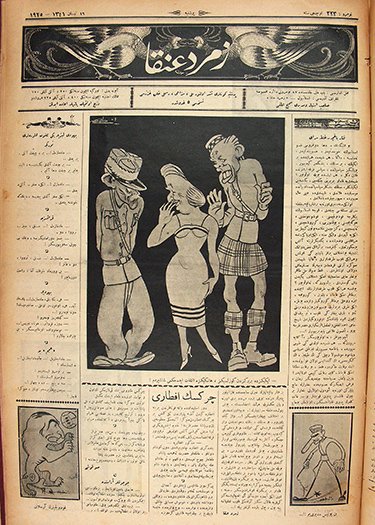76. Today in 1920s Turkey: 16 April 1925 (The Cartoonist’s Armoury Part 1 of 3)

(Cartoon by Ratip Tahir Burak, Zümrüdüanka or “Phoenix,” 16 April 1925, no. 223, page 1.)
Comments:
Ninety-two years ago today Zümrüdüanka featured three of Ratip Tahir Burak’s cartoons on its front page. Each of the three cartoons include at least one caricatured public figure, providing a fitting opportunity to explore the techniques used by cartoonists outlined by celebrated art historian, Ernst H. Gombrich in his article, “The Cartoonist’s Armoury.” Originally published in 1963, the article attempted to delineate “what role the image may play in the household of our mind” (p. 127) by presenting a categorization of the visual cues employed by cartoonists to communicate a range of ideas.
Gombrich introduces six “weapons” (or tools) found in the cartoonist’s armory which are:
- Figures of Speech
- Condensation and Comparison
- Portrait Caricature
- The (Political) Bestiary
- Natural Metaphors
- Powerful Contrasts
A cartoonist who is working within an agreed upon on common cultural context (informed by news, traditions, current events) can use these tools to express more with images than they ever could with lengthy subtitles and words. Most of the categories are self-explanatory and if we read cartoons produced from within our own cultural milieu we should have the necessary “visual literacy” to decipher the images (indeed, it should come quite naturally).
The first cartoon from this issue of Zümrüdüanka employed several of these “tools” including Condensation and Comparison, Portrait Caricature, and even Natural Metaphors. From right to left the cartoon features the following people: John Bull, İsmet İnönü, and a personification of French colonialism as a scrawny old man. John Bull is the name given to the personification of British colonialism and Turkish cartoonists usually give him a uniquely Scottish flare supplying him with a kilt, checkered headgear, and long, bare legs. This choice of clothing betrays a conscious effort to feminize and thus insult the British. In the Turkish context John Bull is almost always portrayed as a tall, spindly, scheming type with a fake, exaggerated smile. These characteristics contribute to the caricaturization of his portrait ("Portrait Caricature").
İsmet İnönü, the “man” located betwixt the two personifications, is also a victim of the cartoonist's imaginative take on "Portrait Caricature". After Mustafa Kemal Atatürk, İsmet İnönü was one of the most important founding fathers of the modern Turkish Republic and in 1925 he was serving as Prime Minister. He had a slightly lop-sided head when viewed from a certain angle and for this reason cartoonists often rendered him with a misshapen cranium. İnönü is caricatured further through his attributes: he is depicted wearing a very seductive dress. Of course, as a powerful political leader (and ex-military officer) this feminization would have been considered a deep insult. He is also feminized in his behavior as he holds his hand up to his face like a woman “unable to decide” between his two “suitors,” France and Britain.
Turkey’s relations with both France and Britain remained delicate after the consecutive World War I and Turkish War of Independence (1919-1922) in which these Allied powers attempted to partition the remaining territories of the Ottoman Empire. Even after peace treaties were signed between these parties several territories remained in dispute through the 1920s. Recently the unresolved territorial issues of Mosul and the British and Alexandretta (Hatay) with France were both in the news. The cartoon seems to be suggesting that İnönü is not being decisive enough or “firm” enough in his handling of these two situations. The cartoon pokes fun equally at both the home team unable to effectively negotiate and the foreign “suitors” attempting to still pursue these territories. And even though the text below suggests that İnönü is smitten with both countries we, as viewers, are not to be tricked as the cartoonist has afforded us a “real” vision of these players. According to our privileged view, neither of the personifications appear desirable and the woman in the middle is no catch herself. Therefore, by condensing the political situation into a single frame occupied by three players and comparing their interaction to courtship or romance the cartoonist the cartoonist is able to to put into a single image what it has just taken me 800+ words to explain ("Condensation and Comparison"). Finally, in comparing international politics to the competitive field of human courtship, the artist is also evoking a natural phenomenon and thus one that is easy for many readers to detect and recognize ("Natural Metaphors").
Provocative cartoons such as this one became the journal’s own downfall. Indeed, this issue turned out to be the journal’s second-to-last publication. Earlier in 1925 the Turkish government passed its infamous Takrir-i Sükun Kanunu or “Law for the Maintenance of Order” which allowed municipalities to shut down periodicals that published materials deemed to disrupt public order. Zümrüdüanka was one of this law’s many victims.
English
— Both of you are equally handsome, I can’t decide which of you to pay attention to!
Türkçe
— İkiniz de birbirinizden güzelsiniz, hanginize iltifat edeceğimi şaşırdım!
Source Cited
Gombrich, Ernst Hans. “The Cartoonist’s Armoury.” In: Meditations on a Hobby Horse, and Other Essays on the Theory of Art, 127-142. London: Phaidon Press, 1994.

(Entire page, Zümrüdüanka or “Phoenix,” 16 April 1925, no. 223, page 1.)